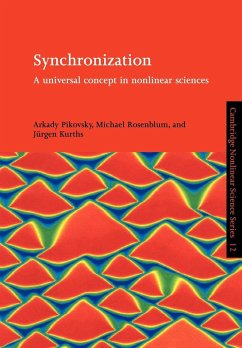Arkady Pikovsky / Michael Rosenblum / Jürgen Kurths
Synchronization
A Universal Concept in Nonlinear Sciences
Herausgeber: Kurths, Jurgen; Rosenblum, Michael; Pikovsky, Arkady
Arkady Pikovsky / Michael Rosenblum / Jürgen Kurths
Synchronization
A Universal Concept in Nonlinear Sciences
Herausgeber: Kurths, Jurgen; Rosenblum, Michael; Pikovsky, Arkady
- Broschiertes Buch
- Merkliste
- Auf die Merkliste
- Bewerten Bewerten
- Teilen
- Produkt teilen
- Produkterinnerung
- Produkterinnerung
The book describes synchronization phenomena using both classical results and more recent developments.
Andere Kunden interessierten sich auch für
![It's a Nonlinear World It's a Nonlinear World]() Richard H. EnnsIt's a Nonlinear World52,99 €
Richard H. EnnsIt's a Nonlinear World52,99 €![Numerical Algebra, Matrix Theory, Differential-Algebraic Equations and Control Theory Numerical Algebra, Matrix Theory, Differential-Algebraic Equations and Control Theory]() Numerical Algebra, Matrix Theory, Differential-Algebraic Equations and Control Theory75,99 €
Numerical Algebra, Matrix Theory, Differential-Algebraic Equations and Control Theory75,99 €![Numerical Algebra, Matrix Theory, Differential-Algebraic Equations and Control Theory Numerical Algebra, Matrix Theory, Differential-Algebraic Equations and Control Theory]() Numerical Algebra, Matrix Theory, Differential-Algebraic Equations and Control Theory74,99 €
Numerical Algebra, Matrix Theory, Differential-Algebraic Equations and Control Theory74,99 €![Surface Mount Technology Surface Mount Technology]() Ray P. PrasadSurface Mount Technology37,99 €
Ray P. PrasadSurface Mount Technology37,99 €![Complex Systems: Chaos and Beyond Complex Systems: Chaos and Beyond]() Kunihiko KanekoComplex Systems: Chaos and Beyond83,99 €
Kunihiko KanekoComplex Systems: Chaos and Beyond83,99 €![Simple mathematical models of gene regulatory dynamics Simple mathematical models of gene regulatory dynamics]() Michael MackeySimple mathematical models of gene regulatory dynamics37,99 €
Michael MackeySimple mathematical models of gene regulatory dynamics37,99 €![Methods of Small Parameter in Mathematical Biology Methods of Small Parameter in Mathematical Biology]() Jacek BanasiakMethods of Small Parameter in Mathematical Biology74,99 €
Jacek BanasiakMethods of Small Parameter in Mathematical Biology74,99 €-
-
-
The book describes synchronization phenomena using both classical results and more recent developments.
Hinweis: Dieser Artikel kann nur an eine deutsche Lieferadresse ausgeliefert werden.
Hinweis: Dieser Artikel kann nur an eine deutsche Lieferadresse ausgeliefert werden.
Produktdetails
- Produktdetails
- Verlag: Cambridge University Press
- Seitenzahl: 432
- Erscheinungstermin: 19. Februar 2007
- Englisch
- Abmessung: 244mm x 170mm x 24mm
- Gewicht: 741g
- ISBN-13: 9780521533522
- ISBN-10: 052153352X
- Artikelnr.: 21517046
- Herstellerkennzeichnung
- Books on Demand GmbH
- In de Tarpen 42
- 22848 Norderstedt
- info@bod.de
- 040 53433511
- Verlag: Cambridge University Press
- Seitenzahl: 432
- Erscheinungstermin: 19. Februar 2007
- Englisch
- Abmessung: 244mm x 170mm x 24mm
- Gewicht: 741g
- ISBN-13: 9780521533522
- ISBN-10: 052153352X
- Artikelnr.: 21517046
- Herstellerkennzeichnung
- Books on Demand GmbH
- In de Tarpen 42
- 22848 Norderstedt
- info@bod.de
- 040 53433511
Arkady Pikovsky was part of the Max-Planck research group on nonlinear dynamics, before becoming a professor at the University of Potsdam, Germany. A member of the German and American Physical Societies, he is also part of the Editorial Board of Physical Reviews E for the term 2000-2002. Before this, he was a Humboldt fellow at University of Wuppertal. His PhD focusses on the theory of chaos and nonlinear dynamics, and was carried out at the Institute of Applied Physics of the USSR Academy of Sciences. Arkady Pikovsky studied radiophysics and physics at Gorky State University, and started to work on chaos in 1976, describing an electronic device generating chaos in his Diploma thesis and later proving it experimentally.
Preface
1. Introduction
Part I. Synchronization Without Formulae: 2. Basic notions: the self-sustained oscillator and its phase
3. Synchronization of a periodic oscillator by external force
4. Synchronization of two and many oscillators
5. Synchronization of chaotic systems
6. Detecting synchronization in experiments
Part II. Phase Locking and Frequency Entrainment: 7. Synchronization of periodic oscillators by periodic external action
8. Mutual synchronization of two interacting periodic oscillators
9. Synchronization in the presence of noise
10. Phase synchronization of chaotic systems
11. Synchronization in oscillatory media
12. Populations of globally coupled oscillators
Part III. Synchronization of Chaotic Systems: 13. Complete synchronization I: basic concepts
14. Complete synchronization II: generalizations and complex systems
15. Synchronization of complex dynamics by external forces
Appendix 1. Discovery of synchronization by Christiaan Huygens
Appendix 2. Instantaneous phase and frequency of a signal
References
Index.
1. Introduction
Part I. Synchronization Without Formulae: 2. Basic notions: the self-sustained oscillator and its phase
3. Synchronization of a periodic oscillator by external force
4. Synchronization of two and many oscillators
5. Synchronization of chaotic systems
6. Detecting synchronization in experiments
Part II. Phase Locking and Frequency Entrainment: 7. Synchronization of periodic oscillators by periodic external action
8. Mutual synchronization of two interacting periodic oscillators
9. Synchronization in the presence of noise
10. Phase synchronization of chaotic systems
11. Synchronization in oscillatory media
12. Populations of globally coupled oscillators
Part III. Synchronization of Chaotic Systems: 13. Complete synchronization I: basic concepts
14. Complete synchronization II: generalizations and complex systems
15. Synchronization of complex dynamics by external forces
Appendix 1. Discovery of synchronization by Christiaan Huygens
Appendix 2. Instantaneous phase and frequency of a signal
References
Index.
Cycling attractors of coupled cell systems and dynamics with symmetry.- Modelling diversity by chaos and classification by synchronization.- Basic Principles of Direct Chaotic Communications.- Prevalence of Milnor Attractors and Chaotic Itinerancy in 'High'-dimensional Dynamical Systems.- Generalization of the Feigenbaum-Kadanoff-Shenker Renormalization and Critical Phenomena Associated with the Golden Mean Quasiperiodicity.- Synchronization and clustering in ensembles of coupled chaotic oscillators.- Nonlinear Phenomena in Nephron-Nephron Interaction.- Synchrony in Globally Coupled Chaotic, Periodic, and Mixed Ensembles of Dynamical Units.- Phase synchronization of regular and chaotic self-sustained oscillators.- Control of dynamical systems via time-delayed feedback and unstable controller.
Preface
1. Introduction
Part I. Synchronization Without Formulae: 2. Basic notions: the self-sustained oscillator and its phase
3. Synchronization of a periodic oscillator by external force
4. Synchronization of two and many oscillators
5. Synchronization of chaotic systems
6. Detecting synchronization in experiments
Part II. Phase Locking and Frequency Entrainment: 7. Synchronization of periodic oscillators by periodic external action
8. Mutual synchronization of two interacting periodic oscillators
9. Synchronization in the presence of noise
10. Phase synchronization of chaotic systems
11. Synchronization in oscillatory media
12. Populations of globally coupled oscillators
Part III. Synchronization of Chaotic Systems: 13. Complete synchronization I: basic concepts
14. Complete synchronization II: generalizations and complex systems
15. Synchronization of complex dynamics by external forces
Appendix 1. Discovery of synchronization by Christiaan Huygens
Appendix 2. Instantaneous phase and frequency of a signal
References
Index.
1. Introduction
Part I. Synchronization Without Formulae: 2. Basic notions: the self-sustained oscillator and its phase
3. Synchronization of a periodic oscillator by external force
4. Synchronization of two and many oscillators
5. Synchronization of chaotic systems
6. Detecting synchronization in experiments
Part II. Phase Locking and Frequency Entrainment: 7. Synchronization of periodic oscillators by periodic external action
8. Mutual synchronization of two interacting periodic oscillators
9. Synchronization in the presence of noise
10. Phase synchronization of chaotic systems
11. Synchronization in oscillatory media
12. Populations of globally coupled oscillators
Part III. Synchronization of Chaotic Systems: 13. Complete synchronization I: basic concepts
14. Complete synchronization II: generalizations and complex systems
15. Synchronization of complex dynamics by external forces
Appendix 1. Discovery of synchronization by Christiaan Huygens
Appendix 2. Instantaneous phase and frequency of a signal
References
Index.
Cycling attractors of coupled cell systems and dynamics with symmetry.- Modelling diversity by chaos and classification by synchronization.- Basic Principles of Direct Chaotic Communications.- Prevalence of Milnor Attractors and Chaotic Itinerancy in 'High'-dimensional Dynamical Systems.- Generalization of the Feigenbaum-Kadanoff-Shenker Renormalization and Critical Phenomena Associated with the Golden Mean Quasiperiodicity.- Synchronization and clustering in ensembles of coupled chaotic oscillators.- Nonlinear Phenomena in Nephron-Nephron Interaction.- Synchrony in Globally Coupled Chaotic, Periodic, and Mixed Ensembles of Dynamical Units.- Phase synchronization of regular and chaotic self-sustained oscillators.- Control of dynamical systems via time-delayed feedback and unstable controller.








